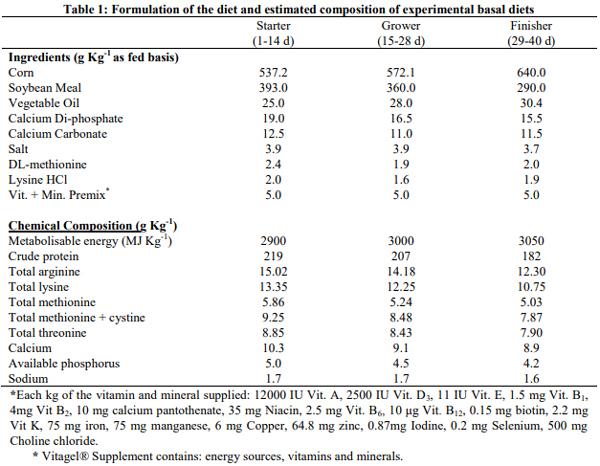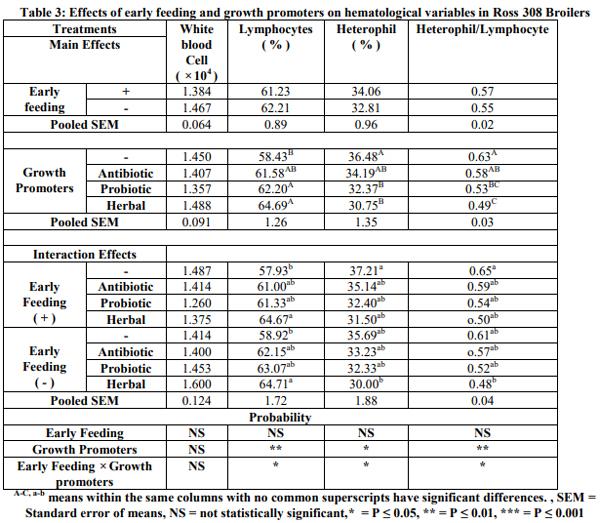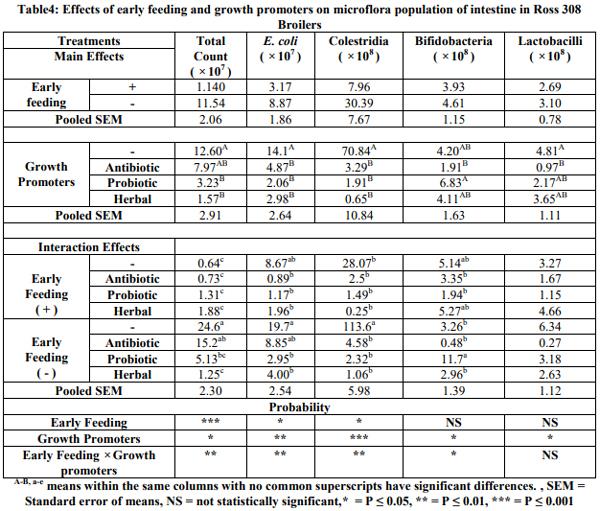The Role of Early Feeding on the Effects of Alternative Antibiotics on Blood Picture, Immune Competency and Gut Health in Broilers
This experiment was designed to evaluate the effects of early feeding programs (FP) (early access to vitagel® and versus delayed access to feed post hatch for 24 hours) and growth promoters (GP) as well as investigate the synergistic effects of and GP on blood picture , immune competency , and intestinal microbiology of broiler. A total of 1200 male chicks were allotted into two groups. In hatchery: Fed groups (received nutritional supplement (vitagel®) during transport until 24 hours post hatch and deprived groups restricted within transport box for 24 hours post hatch without nutritional supplement. In farm, the birds divided into negative control (basal diet) and positive control (antibiotic (10mg /kg feed); Bacillus subtillis (200mg /kg feed) and medicinal plant blend (1g /kg feed).The immune response against NDV(Newcastle disease) was significantly increased (p<0.05), while antibody titers(Ab) against SRBCs (sheep red blood cells) were numerically high by vitagel ®. Ab against SRBCs significantly enhanced (p<0.001) with natural growth promoter(Bacillus subtillis and Medicinal plants blend ).Vitagel® reduces the pathogenic bacteria(p<0.05), also it maintains on beneficial bacteria. Growth promoters showed significant reduced (p<0.001) of pathogenic bacteria (Clostrodium Spp and E.Coli) and increased (P<0.05) of beneficial bacteria (Lactobacilli and Bifidobacteria ).The Lymphocyte(L) was higher with natural GP or interaction effect of vitagel® and GP (p<0.05), the Heterophils(H) to Lymphocyte ratio (H/L ratio ) and Heterophil were lower (P<0.01) with interaction effect or natural GP. Results concerning the early feeding supplement confirmed the fact that early feeding post hatch with growth promoters may affect the gut health and immune competence.
Keywords: early feeding supplement, immunity, bacteriology, growth promoters, blood picture.




Ali , A.T.Y. (2011).Effect of drug free feeding programs on growth performance , intestinal morphology and carcass quality of broiler chicks . Master Thesis .Veterinary Medicine College . Zagazia University . Egypt.
Alhotan , R.A. ( 2011). Effect s of early feed restriction during delayed placement on the performance and gut health of broilers . master thesis . Unversity of Nebraka, Lincoln . Nebraaska .
AL-Ankari , AS. ; Zaki, MM. ; Alsultan, SI; (2004). Use of habakmint (menthalongifolia ) in broiler chicken diet . Internation Journal of Poultry Science , 3:629-634.
Anon, (1971). Methods for examining poultry biologies and for identifying avian pathogens. Nat. Acad. Scl, Washington D. C, Pp. 270-294.
Ao Z, Kocher A and Choct M, (2012). Effect of dietary additives and early feeding on performance, gut development and immune of broiler chicken challenged with Clostridium perfringes. Asian–Aust Sci 25(4):541- 551
Batal , A. B. and Parsons , C.M. (2002) . Effect of fasting versus feeding oasis after hatching on nutrient utilization inchick . Poultry Science , 81 : 853-859.
Bhanja, S.K.;Anjalidevi,C.;Panda, A.K.and ShyamaSunder,G.(2010). Effect of post hatch nutrient intubation on performance , intestinal growth , meat yield and immune response in broiler chickens . Asian –Aust. J. Animal.Sci23(4):515-520.
Bigot, K., S. Mignon-Grasteau, M. Picard, and S. Tesseraud. 2003. Effects of delayed feed intake on body, intestine, and muscle development in neonate broilers. Poult. Sci. 82:781-788.
Biloni, A. ; Quintana , C.F. ;Menconi , A. ; Kallapura, G.; Latorre , J. ; Pixley , C. ; Layton, S. ; Dalmagro, M. ; Hernandez-Velasco , X. ; Wollfenden , A. ; Hargis , B. M. and Tellez , G.(2013). Evalation of effects of Early bird associated with FloraMax-B11 on Salmonella Enteritidis , intestinal morphology andperformance of broiler chicken s . Poultry Science , 92, :2337-2346.
Broiler Nutrition Specifications. Ross 308 Broiler Nutrition Specifications. Aviagen Company, Scotland, (2007) .
Cengiz, O.;Koksal ,H.; Tah,O.; Sevim,O;AVCI, H. ;Epikmen, T. ; Beyaz, D. ;Buyukyoruk,S.; Boyaciooglum,M.; Uner,A. and Onol , A.G. (2012) . Influence of dietary organic acid blend supplementation and interaction with delayed feed access after hatch on broiler growth performance and intestinal health . Veterinary medicina , 57(10): 515-528.
Christensen HR. ; Frokiaer, H. and Pestka , JJ. (2002).Lactobacilli differentially modulate expression of cytokines andmaturation surface markers in Murine Dendritic Cells J. Immunol. 168:171-8.
Coles , E.H .,(1986).Veterinary clinical pathology Edth edition .W.B.Saunders Company .London.Pp 58 Corrier, D.E. and Deloach , J.R. (1990). Evaluation of cell mediated cutaneous basophile hypersensitivity in young chickens by an interdigital skin test . Poult. Sci., 69:403-408.
Dankowiakoska, A. ;Kozlowska, I. ;and Bendnarczyk, M. (2013). Probiotic , prebiotic and symbiotic in poultry .Mode of action , limitation and chievements . Journal of Central European Agricuture , 14 (1): 467-478.
Dibner, J. J., C. D. Knight, M. L. Kitchell, C. A. Atwell, A. C. Downs, and F. J. Ivey. (1998). Early feeding and development of the immune system in neonatal poultry. J. Appl. Poult. Res. 7:425-436.
Dibner (1999). .Feeding hatchling poultry . Feed . Int. 12:30-34 Dibner , JJ ; and Knight CD (1999). Early feeding and gut health in hatchling . Int. Hatch . Pract. 14 :1.
Engber,G.; Ranjitkar,S.T. and Louridsen , C.(2013). The influence of early nutrition on body weight , gastrointestinal microflora and humeral immunology of broiler . 19 th European Symposium on Poultry Nutrition . Postdam/Germany . August 26-24 ,(2013).
Erf, G.F. ; Bottje , W. ; Bersi , T.K. ; Headrick, M.D. and Frilts , C.A. (1998). Effects of dietary vitamin E. on immune system in broiler : Altered proportions of CD4T cells in the thymus and spleen . Poult . Sci , 77:529- 537.
Fanguy, R.C., Misera, L.K. Vo, K.C. Blohowiak, C.C. & Kreuger W.F., 1980. Effect of delayed placement on mortality and growth performance of commercial broilers. Poultry Science 59: 1215-1220.
Fathi, M.M., Ali, R.A. and Qureshi, M.A. (2003). Comparison of immune responses of inducible Nitric Oxide Synthesis (iNOS) hyper-and hypo responsive genotypes of chickens. International Journal of Poult. Sci. 2: 280- 286.
Fridman , A. and Bar-Shira , E. (2005). Effect of nutrition on development of immune competence in chicken 's gut –associated lymphoid system . Proceeding of the 15th European Symposium on Poulty Nutrition , Balatonfured , Hungary , 25-29, septimber , 2005 . Pp 247-255. World 's Poultry Science Association (WPSA).,
Fuller ,R. A. (1989). Areview: Probiotic in man and Animals . J. Appl.Bacteriol. 66:365-78. Ghasemi, H.A. ; Kasani, N. ; Taherpour, K. (2014). Effect of black cumin seed , a prebiotic and synobiotic on growth , immune response and blood traits of male broilers . Liverstock Science, 164:128-134.
Golian, A. ; Azghadi, M. A. and Seghi, M. (2009): the comparison of supplemental cumin seed and cumin seed meal with prebiotic fermacto on blood metabolites and performance of broiler chicks Journal of Animal Veterinary Advances 9(19) 2546-2551.
Gudev, D. ; Popova-Ralcheva, S. ;Moneval, P. ;Bonovska, M. Valchev, G. and Valcheva,A. (2004). Effect of supplemental sangrovit on some biochemical indices and leukocytes phagocytic activity in growing pigs . Arch. Zootec , 7:123-34.
Gue , F.C. ; Savelkoul , H.FJ. ;Kwakkel, R.P. ; Williams, B.A. and Verstegen, M.W.A. (2003) Immunoactive , medicinal properties of mushroom and herbpolysaccharides and their potential use in chicken diets . World's Poult .Science Journal 59:427-440.
Hahn , D.L. (2014 ) . The effects of feeed additives , Housing system and stress on salmonella shedding in single comb white and brown laying hen . Phd. Thesis . Faculty of graduate college . Nebraska University . Lincolin.
Hangalapura , B.N. ; Nieuwland , M.G.B. ; Devries Reillingh , G. ; Buyse , J. ; VanddeBrabdt , H.; Kemp, B. and Parmentier , H.K. (2005) . Severe feed restriction enhances innate immunity but suppresses cellular immunity in chicken lines divergently selected for antibody responses . Poult. Sci . 84:1520-1529.
Juul –Madsen , HR. ;Sun , G. ; Sorensen, P(2004). Influence of early or late start of first feeding on growth and immune phenotypeof broilers . Br. Poult .Scie. , 45:210-222.
Lesson , S. and Summers , D. (2001) . Nutrition of the chicken . (4edth) . Published by University books .Guelph, Ontario, Canada.Pp440-443
Lumpkins , B.S. (2007). Evaluation of intestinal development and the bacterial community in the gastrointestinal tract of poultry . PhD. Thesis. Graduate Faculty .Georgia University. Athens. Georgia.
Mahmoodibadzardi , M. ; Ghazanfori,S. ; Salehi, A. ; AND Sharifi , D. (2014). Growth performance , carcass characteristic , antibody titer and blood parameters in broiler chicken fed dietary myrtle (uyrtuscommunis) essential oil as an alternative to antibiotic growth promoters . Poultry Science Journal 2(1)37-49.
Maiorka , A. and Dahlke F. (2006). Broiler adaptation to post-hatching period . Ciencia Rural , Santamaria , 36 (n):701-708.
Mathivanan , R. and Kalaiarasi, K. (2007). Panchagavya and Andrographis Panculata as alternatives to antibiotic growth promoters on hematological , Serum Biochemical parameters and immune status of broilers. Poult . Sci . 44:198-204.
Matrin ,A. E. A. ; Dunnington , W.B. ;Gross , W.E. ; Briles , R. ; Briles , W. and Siegel , P. B. (1990). Production traits and alloantigen systems in lines of chickens selected for high or low antibody responses to sheep erythrocytes . Poult.Sci. ,69:871-878.
Mead Adam, G. C. and Adams, B. W. (1975). Some observations on the caecal microflora of the chick during the first two weeks of life. Br. Poult. Sci. 16(2): 169–176.
Nikpiran , H. ; Taghavi, M. ; Khodaddi , A. and Athari,S.S. (2013) . Ifluence of probiotic and prebiotic on broiler chicken performance and immune status . Journal of Novol Applied Science 2 (8) :256-259.
Nnadi ,P.A. Eze , p.c. and EZEMA , W. S. (2010). Influence of delayed feeding on the performance , Development and response of immune system to Newcastle disease vaccination in chicken . International Journal of Poultry Science 9 (7):669-674.
Noy , Y. and Sklan ,D. (1998). Metabolic response to early nutrition . J. APPL. Poultry Res., 7:437-451.
Null, G., 2001. The antioxidant Vitamin-Vitamin C in www. Vitaminfoundation.org. NRC., 1994. National Research Council. Nutrient requirements of Poultry. 9th revised. ed. National Academy Science.,Washington. DC.
Panda , A. K. ; Rajum , V. ; Rao , L.N. ; Rama , S.V. ; Sunder , G. Sham; Reddy M.R. (2010). Effect of post hatch feed deprivation on growth , immune organs development and immune competence in broiler chickens . Animal Nutrition and Feed Technology , 10(1): 9-17.
Paul,M.M. (2015) . Effect of posthatching holding time and early nutrition strategies on growth performance , carcass and skeletal characteristics of young chicken . Masster thesis . Agriculture . University of Kentucky . USA .
Pall, L ; Dublecz, K . ; Husveth , F. and Kulcsar, M.(2013).Early nutrition affect plasma corticosterone of broiler chicks . 19th European symposium on poultry nutrition .August 26-29, Potsdam-Germany .
Potturi, P., Patterson, J., and Applegate, T. (2005). Effects of delayed placement on intestinal characteristics in turkey poults. Poult. Sci. 84:816-824.
Rahimi, sh. and Khaksefidi,A. (2006) A comparison betweenthe effect of a probiotic (Bioplus 2B ) and antibiotic (virginiamycin) on the performance of broiler chickens under heat stress condition . Iranian Journal of veterinary research, university of Shiraz, Vol.7(3):23-28
Rahimi, S. ;TeymouriZadeh, Z. ; KarimiTorshizi,M.A. ; Omiddbargi, R. and Rokni , H. (2011). Effect of the three herbal extracts on growth performance , Immune system , Blood factors and intestinal selected bacterial population in broiler chickens . J.Agr.Sci. Tech. 13:527-539.
Sadeghi , GH. ; Karimi, A; PadidarJahromi, SH. ;Azizi , j. ;Daneshmand , A.(2012).Effectof cinnamon , thyme and turmeric infusions on the performance andimmune response in of 1 to 21 day old male broiler . Brazilian Journal of Poultry Science , 14(1):15-20.
Savino , W. (2002). They thymus gland is atarget in malnutrition . Eur. J. Clin. Nutr. , 56(3):546-549
Scottosanti (2009). Incubation temperature and post-hatch stress effects on immune parameters , immune system . Master Thesis . Faculty of the Virginina Poly Technic Institute . State University .
Shinde , A. S. ; Goel, A ; Mehra, M. ; Rokade , J. ; Bhadauria, P. ; Mandal , A.B. and Bhanja , S.K. (2015). Delayed post hatch feeding affects performance , Intestinal morphology and expression pattern of nutrient transporter genes in egg type . Nutrition and Food Science , 5(3):2-11. SPSS (2001): SPSS/PC + (2001), for the PC/XT. SPSS INC.
Uni, Z. and Ferket , RP. (2004). Methods for early nutrition and their potential . World's Poult. Sci. J. 60:101- 111.
VanDeven , L.J. (2012) Effects of hatching time and hatching system on broiler chicks development . PhD. Thesis . Wageningen Unversity . Netherland.
Wegman, T. G. and Smithies, O. (1966). A simple hemagglutination system requiring small amounts of red cells and antibodies. Transfusion, 6: 67-73.
Yadav , G.B. ; Kadam, A.S. ;Pachpande , A.M. ; Lambate , V.D. ; Maini,S. and Ravikanth, K. (2010).Post hatch histo –morphological studies of small intestinal development in chicks fed with herbal chick nutritional supplement . Internatonal journal of poultry Science , 9 (9):851-855.
Yakheshi , S. ;Rahimi , S. ; GharibNaseri , K. (2011). The effects of comparison of herbal extracts , antibiotic , probiotic and organic acid on serum lipids , immune response , GITmicrobial population , intestinal morphology and performance of broilers . Journal of Medicinal Plants , 10(37):80-95.










.jpg&w=3840&q=75)